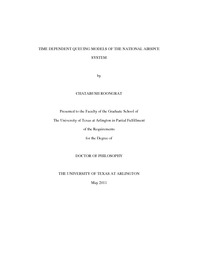
ATTENTION: The works hosted here are being migrated to a new repository that will consolidate resources, improve discoverability, and better show UTA's research impact on the global community. We will update authors as the migration progresses. Please see MavMatrix for more information.
Show simple item record
| dc.contributor.author | Roongrat, Chatabush | en_US |
| dc.date.accessioned | 2011-07-14T20:48:31Z | |
| dc.date.available | 2011-07-14T20:48:31Z | |
| dc.date.issued | 2011-07-14 | |
| dc.date.submitted | January 2010 | en_US |
| dc.identifier.other | DISS-11039 | en_US |
| dc.identifier.uri | http://hdl.handle.net/10106/5668 | |
| dc.description.abstract | Air transportation in the US system has dramatically changed in the past few decades. The National Airspace System (NAS) has increasingly become congested. A high volume of air traffic demand is one of the major challenges of the NAS. However, air traffic is very difficult to study due to many uncertainties involved. It is important that we be able to understand the relationship under uncertainties due to aviation operations, precision of navigation and control, and traffic flow efficiency. Many queuing models have been studied to better understand and quantify these relationships. In the past decade, most queuing network models assume that inter-arrival times and service times are exponentially distributed and stationary, which may not be suitable for all scenarios. These queuing models are time invariant and have several drawbacks. In particular, they do not account for increases and decreases in demand that are commonly observed in the NAS throughout a day. Previously, the NAS has been studied and analyzed by using traditional Makovian queues. However, observations from simulations of real traffic data reveal that the inter-arrival time and service time probability distributions cannot be represented by exponential probability density functions. The Coxian distribution is a phase-type distribution that has gained special importance in the research on queuing networks. In this study, several methods of fitting Coxian distribution to data together with different time dependent queuing models of the NAS are developed and discussed.In the past few decades, Coxian distributions have become increasingly more popular. The probability distribution functions for inter-arrival times/service times of airspace systems cannot be represented by traditional probability distribution functions. In the first part of this dissertation, we describe different algorithms to fit Coxian distributions to the service times of major Air Traffic Centers. Several fitting methods are developed and discussed. Finally, we compare and evaluate those methods by using the mean square error (MSE) and the number of phases in the distribution.In the second part of this dissertation, we discuss a practical approach for modeling the NAS with time-dependent Coxian queues. Time-dependent Cm(t)(t)/Ck/s queuing models of the National Airspace are developed in which the inter-arrival distribution is a time-dependent piece-wise constant Coxian random variable, and the service time distribution is a Coxian random variable. We describe an algorithm for calibrating a Cm(t)(t)/Ck/s queuing model from simulated data of an Air Route Traffic Control Center and an algorithmic approach to determine average measures of the queues. Finally, we give future directions for studying such queuing models. | en_US |
| dc.description.sponsorship | Rosenberger, Jay M. | en_US |
| dc.language.iso | en | en_US |
| dc.publisher | Industrial & Manufacturing Engineering | en_US |
| dc.title | Time Depedent Queuing Models Of The National Airspace | en_US |
| dc.type | Ph.D. | en_US |
| dc.contributor.committeeChair | Rosenberger, Jay M. | en_US |
| dc.degree.department | Industrial & Manufacturing Engineering | en_US |
| dc.degree.discipline | Industrial & Manufacturing Engineering | en_US |
| dc.degree.grantor | University of Texas at Arlington | en_US |
| dc.degree.level | doctoral | en_US |
| dc.degree.name | Ph.D. | en_US |
Files in this item
- Name:
- Roongrat_uta_2502D_11039.pdf
- Size:
- 1.854Mb
- Format:
- PDF
This item appears in the following Collection(s)
Show simple item record


